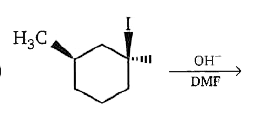In which reaction will an increase in the volume of the container favor the formation of products?
C(s)+H2O(g)⇔CO(g)+H2(g)
H2O(g)+I2(g)⇔2HI(g)
4NH3(g)+5O2(g)⇔4NO(g)+6H2O(l)
3O2(g)⇔2O3(g)
The correct Answer is:1
To determine in which reaction an increase in the volume of the container will favor the formation of products, we need to analyze the change in the number of gaseous moles (ΔN) for each reaction. The principle we will use is that if the number of gaseous moles increases (ΔN > 0), then an increase in volume will favor the formation of products.
1. Identify the Reactions:
We have four reactions to analyze. We will denote them as Reaction A, Reaction B, Reaction C, and Reaction D.
2. Calculate ΔN for Each Reaction:
- Reaction A:
- Reactants: Carbon (solid) + Water (gas) → Products: 2 Gaseous Products
- Moles of Reactants: 0 (for solid carbon) + 1 (for gaseous water) = 1
- Moles of Products: 2 (gaseous products)
- ΔN = Moles of Products - Moles of Reactants = 2 - 1 = 1 (ΔN > 0)
- Reaction B:
- Reactants: Water (gas) + Iodine (gas) → Products: HI (gas)
- Moles of Reactants: 1 (water) + 1 (iodine) = 2
- Moles of Products: 2 (HI)
- ΔN = 2 - 2 = 0 (ΔN = 0)
- Reaction C:
- Reactants: 4 Gaseous Reactants → Products: Water (liquid) + 5 Gaseous Products
- Moles of Reactants: 4
- Moles of Products: 5 (gaseous products)
- ΔN = 5 - 4 = 1 (ΔN > 0)
- Reaction D:
- Reactants: 3 Gaseous Reactants → Products: 2 Gaseous Products
- Moles of Reactants: 3
- Moles of Products: 2
- ΔN = 2 - 3 = -1 (ΔN < 0)
3. Determine Which Reaction Favors Products with Increased Volume:
- From the calculations:
- Reaction A: ΔN = 1 (favors products)
- Reaction B: ΔN = 0 (no effect)
- Reaction C: ΔN = 1 (favors products)
- Reaction D: ΔN = -1 (favors reactants)
4. Conclusion:
An increase in volume will favor the formation of products in Reaction A and Reaction C since both have ΔN > 0. However, since the question asks for a single reaction, we can conclude that Reaction A is a clear example where an increase in volume favors product formation.
Final Answer:
Reaction A will favor the formation of products with an increase in the volume of the container.
We have four reactions to analyze. We will denote them as Reaction A, Reaction B, Reaction C, and Reaction D.
- Reaction A:
- Reactants: Carbon (solid) + Water (gas) → Products: 2 Gaseous Products
- Moles of Reactants: 0 (for solid carbon) + 1 (for gaseous water) = 1
- Moles of Products: 2 (gaseous products)
- ΔN = Moles of Products - Moles of Reactants = 2 - 1 = 1 (ΔN > 0)
- Reactants: Water (gas) + Iodine (gas) → Products: HI (gas)
- Moles of Reactants: 1 (water) + 1 (iodine) = 2
- Moles of Products: 2 (HI)
- ΔN = 2 - 2 = 0 (ΔN = 0)
- Reactants: 4 Gaseous Reactants → Products: Water (liquid) + 5 Gaseous Products
- Moles of Reactants: 4
- Moles of Products: 5 (gaseous products)
- ΔN = 5 - 4 = 1 (ΔN > 0)
- Reactants: 3 Gaseous Reactants → Products: 2 Gaseous Products
- Moles of Reactants: 3
- Moles of Products: 2
- ΔN = 2 - 3 = -1 (ΔN < 0)
- From the calculations:
- Reaction A: ΔN = 1 (favors products)
- Reaction B: ΔN = 0 (no effect)
- Reaction C: ΔN = 1 (favors products)
- Reaction D: ΔN = -1 (favors reactants)
An increase in volume will favor the formation of products in Reaction A and Reaction C since both have ΔN > 0. However, since the question asks for a single reaction, we can conclude that Reaction A is a clear example where an increase in volume favors product formation.
Reaction A will favor the formation of products with an increase in the volume of the container.
Topper's Solved these Questions
- BOOK - RESONANCE ENGLISHCHAPTER - CHEMICAL EQUILIBRIUMEXERCISE - INORGANIC CHEMISTRY(Metallurgy)40videos
CHEMICAL EQUILIBRIUM
- BOOK - RESONANCE ENGLISHCHAPTER - CHEMICAL EQUILIBRIUMEXERCISE - ORGANIC CHEMISTRY(Alkyl Halide, Alcohol,Phenol,Ether)27videos
CHEMICAL EQUILIBRIUM
- BOOK - RESONANCE ENGLISHCHAPTER - CHEMICAL BONDINGEXERCISE - ORGANIC CHEMISTRY(Fundamental Concept )6videos
CHEMICAL BONDING
- BOOK - RESONANCE ENGLISHCHAPTER - D & F-BLOCK ELEMENTS & THEIR IMPORTANT COMPOUNDS EXERCISE - Match the column1videos
D & F-BLOCK ELEMENTS & THEIR IMPORTANT COMPOUNDS
Similar Questions
Knowledge Check
- Question 1 - Select One
In which of the following reaction the increase in pressure will favour the increase in products ?
AN2(g)+O2(g)⇔2NO(g)BPCl3(g)+Cl2(g)⇔PCl5(g)CPCl5(g)⇔PCl3(g)+Cl2(g)D2CO2(g)⇔2CO(g)+O2(g) - Question 2 - Select One
Which reaction results in the formation ofa pair of enantiomers ?
A B
B C
C D
D
- Question 3 - Select One
Which of the following reactions will result in the formation of a chiral centre in the product ?
ACH3CH=CH2+HBr→BCH2=CH2+HOBr→CCH3CH2CH=CH2+HBrH2O2−−→DCH3CH2CH=CH2+HBR→
Increase in volume of container does not affect the equilibria
View SolutionWhat is the order of reaction for which rate becomes half if volume of the container having same amount of reactant is doubled? Assume gaseous phase reaction.
View SolutionWhich of the following dissociations can be encouraged by increasing the volume of the container at constant temperature ?
View SolutionFor the reaction
N2(g)+O2(g)⇔2NO(g)
If pressure id increased by reducing the volume of the container then :View SolutionWhich of the following reactions will result in the formation of a chiral centre in the product?
View Solution

